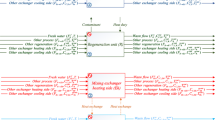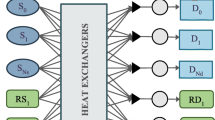Abstract
A superstructure-based mathematical model is established for single-contaminant heat-integrated water networks (HIWN), and the water loss of both wastewater regeneration recycling and regeneration reuse is considered. Furthermore, a sequential optimization procedure is established to achieve multi-objective optimization. The loss rate of water is taken into the mathematical model as there must have water loss in regeneration process, so that the optimization would be more realistic. Two cases are optimized using proposed model with regeneration recycling and regeneration reuse considered, respectively; the results show the differences between these two modes. Compared with the optimization method in the literature, the proposed method is more realistic.








Similar content being viewed by others

Abbreviations
- a :
-
The partition coefficient of contaminant mass load between two subunits
- B :
-
The cost coefficient of regenerated water
- c :
-
The contaminant concentration of streams
- Cp :
-
Specific heat at constant pressure (kJ (kg °C)−1)
- F :
-
Flow rate of stream
- Lr :
-
Loss rate of water in regeneration process
- M :
-
The contaminant load of water using unit (g h−1)
- N :
-
The annual running time (h)
- P :
-
The set of water units before decomposition
- PR :
-
Proportion of annual running time
- Q :
-
Heat (kW)
- r :
-
The removal rate of the contaminant in the regeneration unit R (g h−1)
- R :
-
Regeneration unit
- T :
-
Temperature (°C)
- u :
-
The unit cost ($)
- U :
-
Constant related to the number of connections
- X :
-
The set of water units after decomposition
- y :
-
Binary variables for network connection
- Z :
-
The annual total operating cost of system ($ a−1)
- ξ 1 :
-
Constant which related to the freshwater consumption
- ξ 2 :
-
Constant which related to the amount of regenerated water
- com :
-
Parameters related to decomposition process
- D :
-
Discharge of water using unit
- in :
-
Inlet of water using unit
- min :
-
The minimum value of parameters
- max :
-
The maximum value of parameters
- out :
-
Outlet of water using unit
- s :
-
Definite value
- W :
-
Freshwater consumption
- C :
-
Set of cold streams
- CU :
-
Cooling utility
- F :
-
Flow rate of streams
- H :
-
Set of hot streams
- HU :
-
Heating utility
- k :
-
Temperature degrees
- K :
-
Temperature intervals
- n :
-
Temperature degrees
- m :
-
Hot streams in the set H
- q :
-
Cold streams in the set C
- R :
-
Regeneration unit
- uti:
-
Utility consumption
- b :
-
Water using unit after decomposition
- d :
-
Water using unit
- i :
-
Water using unit
- j :
-
Water using unit
References
Ahmetović E, Kravanja Z (2014) Simultaneous optimization of heat-integrated water networks involving process-to-process streams for heat integration. Appl Therm Eng 62(1):302–317. https://doi.org/10.1016/j.applthermaleng.2013.06.010
Ahmetović E, Ibrić N, Kravanja Z (2014) Optimal design for heat-integrated water-using and wastewater treatment networks. Appl Energ 135:791–808. https://doi.org/10.1016/j.apenergy.2014.04.063
Bagajewicz MJ, Pham R, Manousiouthakis V (1998) On the state space approach to mass/heat exchanger network design *. Chem Eng Sci 53(14):2595–2621. https://doi.org/10.1016/S0009-2509(98)00014-1
Bagajewicz M, Rodera H, Savelski M (2002) Energy efficient water utilization systems in process plants. Comput Chem Eng 26(1):59–79. https://doi.org/10.1016/S0098-1354(01)00751-7
Bogataj M, Bagajewicz MJ (2008) Synthesis of non-isothermal heat integrated water networks in chemical processes. Comput Mater Sci 32(12):3130–3142. https://doi.org/10.1016/j.compchemeng.2008.05.006
Boix M, Montastruc L, Pibouleau L (2011) Minimizing water and energy consumptions in industrial water networks. ICCPE:307–312. https://doi.org/10.3303/CET1124052
Boix M, Pibouleau L, Montastruc L, Azzaro PC, Domenech S (2012) Minimizing water and energy consumptions in water and heat exchange networks. Appl Therm Eng 36(1):442–455. https://doi.org/10.1016/j.applthermaleng.2011.10.062
Chen Z, Hou Y, Li X, Wang J (2014) Simultaneous optimization of water and heat exchange networks. Korean J Chem Eng 31(4):558–567. https://doi.org/10.1007/s11814-013-0236-z
Dong HG, Lin CY, Chang CT (2008) Simultaneous optimization approach for integrated water-allocation and heat-exchange networks. Chem Eng Sci 63(14):3664–3678. https://doi.org/10.1016/j.ces.2008.04.044
Feng X, Bai J, Wang H, Zheng X (2008) Grass-roots design of regeneration recycling water networks. Comput Chem Eng 32(8):1892–1907. https://doi.org/10.1016/j.compchemeng.2007.10.006
Hu N, Feng X, Deng C (2011) Optimal design of multiple-contaminant regeneration reuse water networks with process decomposition. Chem Eng J 173(1):80–91. https://doi.org/10.1016/j.cej.2011.07.040
Hong X, Liao Z, Jiang B, Wang J, Yang Y (2016) Simultaneous optimization of heat-integrated water allocation networks. Appl Energ 169:395–407. https://doi.org/10.1016/j.apenergy.2016.01.059
Kuo, W.-C.J., Smith, R (1998) Designing for the interactions between water-use and effluent treatment. Trans IChem, Part A76, 287—301, doi: https://doi.org/10.1205/026387698524938
Liao Z, Yang Y, Wang J, Jiang B (2007) Optimization of water networks considering thermal integration. Chinese J Chem Eng 58(2):390–402 In Chinese
Leewongtanawit B, Kim JK (2009) Improving energy recovery for water minimization. Energy 34(34):880–893. https://doi.org/10.1016/j.energy.2009.03.004
Liao ZW, Rong G, Wang JD (2011) Systematic optimization of heat-integrated water allocation networks. Ind Eng Chem Res 50(11):6713–6727. https://doi.org/10.1021/ie1016392
Liu Z, Luo Y, Yuan X (2014) Synthesis of energy integrated water networks considering non-isothermal mixing. Chinese J Chem Eng 65(1):285–291.In Chinese. https://doi.org/10.3969/j.issn.0438-1157.2014.01.037
Li R, Wang Y, Feng X (2015) Optimization of single impurity water network considering temperature constraints. Chinese J Chem Eng 66(7):2581–2587. In Chinese. https://doi.org/10.11949/j.issn.0438-1157.20150142
Liu L, Song H, Zhang L, Du J (2017) Heat-integrated water allocation network synthesis for industrial parks with sequential and simultaneous design. Comput Chem Eng. https://doi.org/10.1016/j.compchemeng.2017.10.002
Mao T, Luo Y, Yuan X (2010) Design method of energy integrated water network considering non-isothermal mixing. Chinese J Chem Eng 61(2):369–377 In Chinese
Martínez-Patiño J, Picón-Núñez M, Serra LM, Verda V (2011) Design of water and energy networks using temperature–concentration diagrams. Energy 36(6):3888–3896. https://doi.org/10.1016/j.energy.2010.12.042
Savulescu LE, Smith R (1998) Simultaneous energy and water minimization. In: AIChE Annual Meeting, Miami
Savulescu LE, Sorin M, Smith R (2002) Direct and indirect heat transfer in water network systems. Appl Therm Eng 22(8):981–988. https://doi.org/10.1016/S1359-4311(02)00015-7
Savulescu L, Kim JK, Smith R (2005a) Studies on simultaneous energy and water minimization—part I: systems with no water re-use. Chem Eng Sci 60(12):3279–3290. https://doi.org/10.1016/j.ces.2004.12.037
Savulescu L, Kim JK, Smith R (2005b) Studies on simultaneous energy and water minimization—part II: systems with maximum re-use of water. Chem Eng Sci 60(12):3291–3308. https://doi.org/10.1016/j.ces.2004.12.036
Sahu GC, Bandyopadhyay S (2012) Energy optimization in heat integrated water allocation networks. Chem Eng Sci 69(1):352–364. https://doi.org/10.1016/j.ces.2011.10.054
Sorin Mikhail, Savulescu Luciana (2004) On minimization of the number of heat exchangers in water networks. Heat Transf Eng 25(5):30–38. https://doi.org/10.1080/01457630490459120
Yan F, Wu H, Li W (2016) Simultaneous optimization of heat-integrated water networks by a nonlinear program. Chem Eng Sci 140:76–89. https://doi.org/10.1016/j.ces.2015.09.036
Zhao HP, Wang ZF, Chan TC, Liu ZY (2015) Design of regeneration recycling water networks by means of concentration potentials and a linear programming method. J CLEAN PROD doi 112:4667–4673. https://doi.org/10.1016/j.jclepro.2015.07.130
Funding
The financial support for this research is provided by the National Natural Science Foundation of China under grant 21736008.
Author information
Authors and Affiliations
Corresponding author
Ethics declarations
Conflict of Interest
The authors declare that they have no conflict of interest.
Additional information
Publisher’s Note
Springer Nature remains neutral with regard to jurisdictional claims in published maps and institutional affiliations.
Rights and permissions
About this article
Cite this article
Shen, R., Zhang, Y. & Ma, J. A Mathematical Programming Method for Optimizing the Single-Contaminant Regeneration Heat-Integrated Water Networks. Process Integr Optim Sustain 3, 167–178 (2019). https://doi.org/10.1007/s41660-018-0041-6
Received:
Revised:
Accepted:
Published:
Issue Date:
DOI: https://doi.org/10.1007/s41660-018-0041-6



